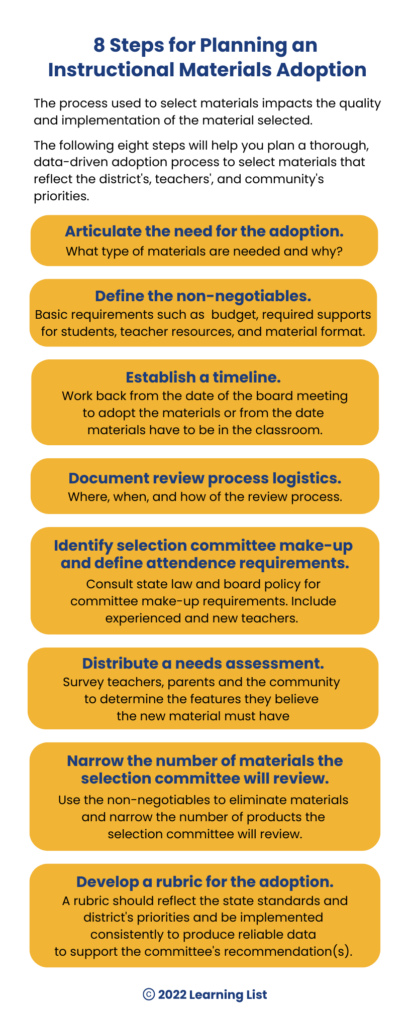If your district or campus will be adopting new materials this year, someone in your campus or district is probably starting to plan the adoption process. Over the last decade, Learning List has assisted hundreds of districts, both formally and informally, with instructional materials adoptions. Based on research regarding selecting and implementing high-quality instructional materials and our own observations of local adoption processes, we offer a four-part blog series on effective strategies for reviewing and selecting instructional resources, both commercially produced and teacher-curated materials.

This first blog in this series provides eight steps for planning a successful adoption process.
(1) Articulate the need for the adoption. The adoption of core materials is typically, though not always, driven by a change in the state standards. In contrast, there are many reasons that districts adopt supplemental materials. To ensure that the administration, teachers and the community understand the need for the adoption, it is important to clearly articulate the reason for and goal of the adoption before beginning the review process.
(2) Define the non-negotiables for the adoption. District or campus leaders should identify the non-negotiables for the adoption. Non-negotiables are the basic requirements, such as the budget, the minimum alignment percentage, instructional model, required supports for students and resources for teachers, and the format of the material. Recent experience with remote learning may suggest additional non-negotiables.
(3) Establish a timeline. Working back from the board meeting where the materials will be adopted or from the deadline for getting materials into the classroom, create a realistic timeline for the entire process, including time for ordering any required technology and providing product-specific professional development for teachers, if appropriate.
(4) Document the review process logistics. Be sure to think through the logistics of the entire review and adoption process, including:
- When, where and how will the selection committee review the materials?
- Will a rubric be used for the adoption, and if so, how will the rubric be developed?
- Will the selection committee review the materials simultaneously in-person or virtually and on their own time?
- If the product samples are online, how will login credentials be provided for all reviewers?
- Will publishers be permitted to present to the selection committee?
- What are the voting protocols for the selection committee’s recommendations?
- How will the new material be distributed?
- Who will be involved in the planning and supporting the implementation?
- Is there an allocation in the budget for professional development and ongoing support?
(5) Identify the makeup of the selection committee and define attendance requirements. State law and/or board policy may dictate the positions that must be represented on the selection committee. At a minimum, the committee should include both experienced and new teachers representing the content area and grade bands covered by the adoption, as well as teachers who provide support services for students, and a technology integration specialist if the material selected may have online components. Additionally, it is important to document attendance requirements and how selection committee members will be replaced if they are unable to meet those requirements.
(6) Distribute a needs assessment. It is critical to gather feedback from teachers, parents and the community about the features they want in the new material. The needs assessment gives all stakeholders, not just the selection committee, a voice in the adoption process. Failure to include this step creates a feeling of disenfranchisement, which may impede the successful implementation.
For a core material, the needs assessment should be distributed to all teachers who will have to use the newly adopted material, as well as staff who will be supporting its implementation, such as instructional coaches, instructional technology staff and parents. In some states, districts are required by state law to survey the community during an adoption, as well. For supplemental materials, distributing the needs assessment to teachers who will be using the new material and to staff who will be supporting its implementation would suffice.
Aggregate the results of the needs assessment to identify the features that the stakeholders believe the new material must have. These features should then be reflected in the district’s rubric for the adoption, which we will discuss in the next blog in this series.
(7) Narrow the number of materials to be reviewed by the selection committee. The list of non-negotiables should be used to eliminate materials from consideration and thus narrow the number of materials the selection committee will review. This can be done by district or campus leaders or by the selection committee. Optimally, the selection committee will conduct a rubric review of between three and five materials.
(8) Develop a rubric. A decision point in any adoption is whether to use a rubric. The next blog in this series will address benefits of using a rubric and how to develop a rubric and implement it consistently.
